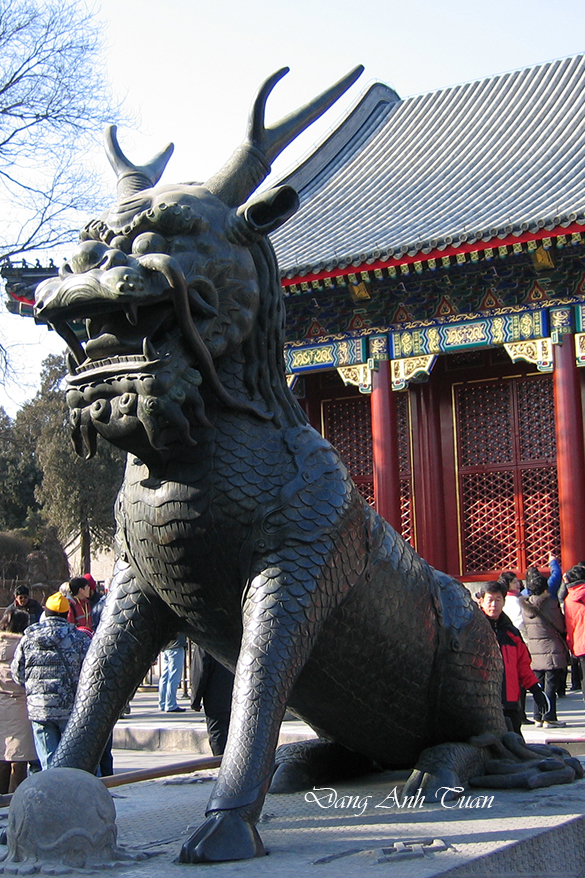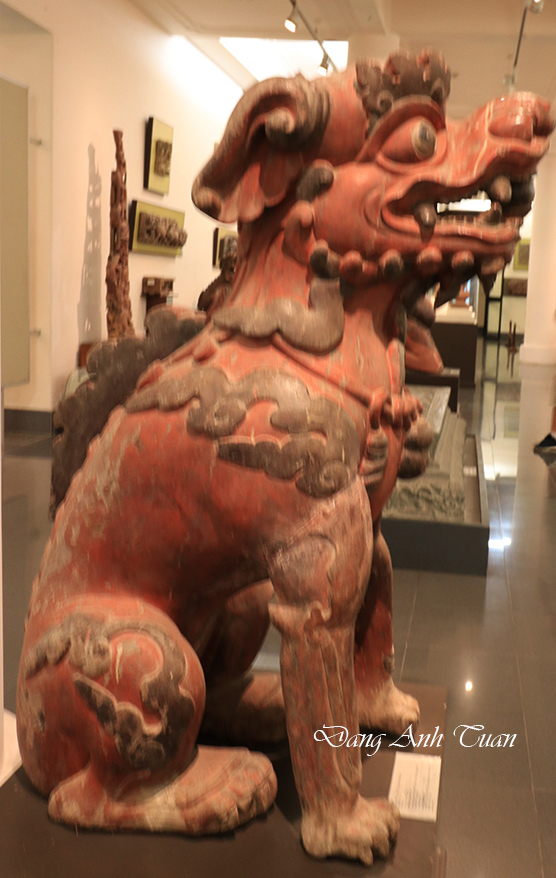Version vietnamienne
Version française
Galerie des photos
In Vietnamese culture, we are accustomed to confusing the animal « nghê (or lion-dog) » with the qilin (kỳ lân)(*). The « lion-dog » does not actually exist in nature, but it is also not a sacred animal borrowed from other cultures. It is a purely Vietnamese creature dating back to ancient times. The nghê has certain traits of the qilin. The main characteristic that distinguishes the nghê from the qilin lies in the toes: the nghê is armed with claws, while the qilin has hooves. Additionally, the nghê has the body of a dog to conform to the identity and culture of the Vietnamese people. In biological dictionaries, there is no animal named « nghê » or « lion-dog, » but only the lion exists. Before the Han (or Chinese) domination, its existence is not detected. Its formation took place within Vietnamese culture starting from the Han domination period, at the end of the Đồng Sơn period and at the time when the Lý dynasty succeeded in gaining full independence. It was during this period that it appeared in architectural construction projects such as the imperial citadel of Thăng Long, the Dâu and Phật Tích pagodas, communal houses, etc. It is an imaginary creature that has never had a precise appearance or form like a tiger or a lion.
That is why there is variation in the modification of the form of this creature. It is a four-legged animal, hornless, with a slender body, which gives it a resemblance to a guard dog. Its particular characteristic is « guarding and protection. » We are accustomed to saying « the phoenix dances and the lion-dog guards » in a proverb. In the Vietnamese dictionary, « chầu » is used to mean « waiting for orders » and « watching. » This creature possesses the « sacred » element intended to ward off and neutralize evil spirits. That is why the lion-dog (or nghê) is visible everywhere in Vietnamese folklore, from the royal court and pagodas to the village entrance, tombs, and house roofs.
According to fine arts specialist Trần Hậu Yên Thế, this creature has a physiognomy, an idyllic appearance that facilitates the first impression, a familiar characteristic, thus revealing its loyalty like a dog with a short tail.
Historian Lê Văn Lan informs us that at the time of creating the mascot, one must initially be inspired by a real animal. This is how the lion-dog is created from the guard dog, just as the dragon is from the crocodile. Everywhere, in every place, the lion-dog must appear with a particular meaning. The nghê located in the cemetery is different from the one found at the entrance of the communal house.
At the top of the roof of the latter (Đinh Bảng for example), the lion-dog, analogous to a phoenix belonging to the animals of the heavens, watches below the movement of the visitor with the purpose of protecting or punishing them depending on their behavior during the visit. However, on the tops of the two columns at the entrance of the Mông Phụ communal house (Đường Lâm), there are two nghê, each with a joyful and welcoming appearance. As for the crouching nghê in front of the tomb, it appears both compassionate and merciful. This in no way manifests the ferocity and power often found in the Chinese lion. The lamp base in the shape of a crouching « lion-dog » found among the late Đông Sơn culture artifacts functions to radiate a light intended to repel and destroy evil spirits. In front of the village entrance, its presence brings protection to the entire village.
According to fine arts specialist Trần Hậu Yên Thế, during the Lê Trung Hưng period (1428-1788), the « lion-dog » was still present near royal tombs. However, the « nghê » no longer exists in most royal tombs under the Nguyễn dynasty but is replaced by the qilin.

But in everyday life, the lion-dog is always visible in the architectural network of hundreds of villages in the North. Until now, statues of the « lion-dog » in a guarding position continue to be made. The lion-dog appears in various forms. It is very well adapted to the landscape of the place where it is present and reflects the spirit of the Vietnamese people. Depending on each period of history, it presents itself in different and distinctive ways, but the basis of its characteristics continues to carry the Vietnamese folkloric element.

(*) Qilin is the word designating the pair of Feng Shui animals where Qi is the male and Lin is the female.
Bibliography:
Đinh Hồng Hải: Những biểu tượng đặc trưng trong văn hóa truyền thống Việt Nam. Tập 3. Các con vật linh. Editions Nhà Xuất Bản thế giới. Hànội 2016
Trần Hậu Yên Thế, Nguyễn Đưc Hoà, Hồ Hữu Long: Phác họa Nghê. Nhà Xuất Bản thế giới.

